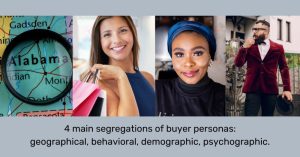Customers are the soul of any business. Before targeting any potential buyer, organisations must ask one main question- who are we targeting really? This is where customer persona mapping comes in the picture. The only way to identify your target audience is to create a customer persona for your business. In this blog, we will define a customer persona, their key traits and the 4 types of customer personas.
What is A Customer Persona?
A customer persona (also known as buyer persona) is a semi-fictional archetype that represents your target audience. The ideal customer will have demographic details such as a pseudonym, their purchase characteristics, behaviours, preferences and emotional connection. This will help you understand their cultural background, motivations to purchase, pain points and expectations.
Difference between the Ideal Customer Profile (ICP) and Customer Persona
A customer persona represents your potential buyer or your prospective customers. The ideal customer profile is the one who is actually going to buy the product since it fits their needs perfectly. You can easily address their issues, requirements, create marketing campaigns and sales processes to accurately target the ICP.
Components of the ICP:
Marketers create their target audience based on qualitative and quantitative data. Here are the main points to consider:
- WHO: Determine the demographics of people- their income level, location, age range, gender, family status and educational levels.
- WHY: Determine the psychographics of people- the emotional reasons for their purchase, passion and interest levels, friction and pain points, challenges, motivations and communication preferences.
- WHAT: Determine the behaviour of people- their interest in products and services, how did they discover the brand and their mode of payment preferred.
Why Is Customer Persona Mapping Important?
Customer persona mapping is crucial for several reasons:
- Enhances targeted marketing: It allows you to tailor your marketing strategies to meet the specific needs of different customer segments.
- Improves product development: You can create products or services that directly address a customer’s pain points and requirements.
- Boosts customer engagement: It helps you craft personalized content and communication that resonates with your audience for higher engagement rates.
- Optimizes resource allocation: It enables you to focus your resources on the most profitable customer segments, maximizing ROI.
- Strengthens customer retention: By aligning your offerings with customer expectations, you can increase brand loyalty.
- Informs strategic decision-making: Get valuable insights that guide your overall business strategy, ensuring it aligns with customer demands.
- Facilitates cross-departmental alignment: It ensures all teams, from marketing to product development, are working towards a common understanding of the target buyer.

How to Create a Buyer Persona Map?
When creating a persona map, it’s important to identify several key characteristics of your target audience. Once you have gathered all this valuable information, it is time to create fictional personas that represent different segments.
What data should be gathered for persona mapping?
Think of a buyer persona as a multidimensional human. Here are some important considerations to target the buyer based on varied segments as follows
- Demographic segmentation: this includes age, race, religion, gender and ethnicity, income group and family status.
- Psychographic segmentation: this considers social class, personality traits, social characteristics, introverted or extroverted.
- Behavioral segmentation: this includes spending patterns, lifestyle habits, products and service usage patterns.
- Geographical segmentation: this considers locations, areas, urban or rural regions etc.
Who are the key stakeholders in persona mapping?
The key stakeholders are the marketing department, product development, sales, and customer service teams. Each team brings valuable insights into the target audience based on their experience and expertise. For example, the marketing team can provide data while the sales team can share feedback from customers. It is an exercise that needs both qualitative and quantitative data points. You can gather these data points by feedback surveys and research protocols.
Identify The 4 Types of Buyer Personas
Effective marketing campaigns start revolving around creating the right kind of persona mapping. However, your ideal customer will also be subject to change as the company grows or expands to different locations. Here are the 4 types of common buyer personas.
1.Decision oriented persona:

They are direct, bold, assertive and have a proactive approach. They seek products and services that are the best in the market among every competitor. They will consider the best that money can buy. While they are solution oriented, they need hard evidence of why they should buy your products and services. When you can solve their problem sooner, they will convert into brand advocates.
2. Efficiency oriented persona:

They do not require details. They only care about the speed and efficiency of work. They do not want to be overwhelmed by statistics, figures or background history. If your product is a perfect fit for their instant requirements, they can generate sales for you faster.
3.Relationship oriented persona:

They are more empathetic and value the relationship side of your business. They often delve into the ‘history’ of business and want to know the story behind your brand. They consider the background and personal information before they make a purchase decision. They also seek personal connection with the brand they support. CX teams have to offer empathy when dealing with relationship oriented personas.
4.Realism oriented persona:

This is a persona that could be skeptical of the products before they invest. They are involved in critical thinking skills and offer realism before purchase. They are impersonal, think through multiple competitors and need time to develop trust with organisations. They are detail oriented and focus on credibility. If you can meet their needs constantly without a glitch, you have the trust of a realistic buyer persona.
Steps for Creating A Persona Map
Consider the following steps before creating a buyer persona mapping template:
- Collect customer data from your existing and potential customers using various online survey tools. Conduct thorough market research, both qualitative and quantitative data. You can also create instant surveys using AI survey builder.
- Identify their pain points, friction points in the customer journey. Assess their needs, requirements, behaviours and spending characteristics.
- Consider all 4 important data- demographic, psychographic, behavioural and geographical data to make analysis.Identify basic demographics such as age, location, job title, and personal attributes. Then dive deeper by asking the right questions about their goals, pain points, personality traits, and psychographics.
- Pre-define your business goals for a long term business standing. Assess competitors and identify your unique selling points and marketing strategies.
- Create user personas of your desired target customer and create various personas examples for your team. You can create multiple different characters , give them different demographic information.
Conclusion
Gathering data to create a customer persona is the first step. One can gather data via email marketing, conducting proper market research on their buyers and assessing customer needs. This needs qualitative and quantitative data. Automate customer data collection with Merren. Publish surveys using Merren’s CX automation and get a high response rate from your customer base. Create long or short surveys using Merren’s CX tools. You can create a survey for free using our free online survey tool. Get a 14 day free trial today.
